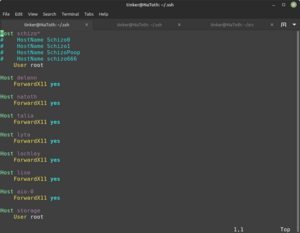Difference between revisions of "HowTo - ssh"
| Line 52: | Line 52: | ||
<span style="color: rgb(132, 63, 161);" >(You may have to enable X11 Forwarding...)</span> | <span style="color: rgb(132, 63, 161);" >(You may have to enable X11 Forwarding...)</span> | ||
=== Remote | === Priveledged Remote Commands (needing root) === | ||
If you want to execute a command remotely that requires '''sudo''', you'll have to add a '''-t''' to the command line or else '''sudo''' with tell you where to go. | If you want to execute a command remotely that requires '''sudo''', you'll have to add a '''-t''' to the command line or else '''sudo''' with tell you where to go. | ||
Revision as of 02:05, 1 January 2023
How To Enable SSH in Linux Mint
Using SSH to get stuff done
Make it easier to connect
Part 1: No passwords!
Don't use password authentication. Use Public Key Authentication.
ssh-keygen- (Note: You only have to do this step once on any particular machine.)
- The passphrase is optional.
ssh-copy-id user@MACHINENAME- This can be done for as many remote machines as you like.
This will simplify your life. From this point on, any time you SSH into (or SCP to/from etc...) the machine known as MACHINENAME while working at the machine you've done this on, you'll be automagically authenticated.
Part 2: ~/.ssh/config
Set up the list of machines you expect to regularly connect to.
vi ~/.ssh/config
& set up options for the various Hosts
There are a lot of things you can configure here.
WIP
(But... An example for now...)
Signing in to a machine
Pretty straightforward:
ssh user@MACHINENAME
This will securely give you a terminal session of the remote machine. (Much like good old telnet... But not quite so sketchily insecure.)
(Note: if the username on the remote machine is the same as on the local machine, you can leave off user@ )
Executing commands remotely
Also, pretty straightforward...
Regular Command-Line commands
ssh user@MACHINENAME "Command to be executed"
GUI (X11) commands
SSH can pass X11 windows through to remote machines.
As an example: Say you want to open a graphical view of the status of a server. I currently use stacer for this task.
ssh -X user@MACHINENAME stacer
(You may have to enable X11 Forwarding...)
Priveledged Remote Commands (needing root)
If you want to execute a command remotely that requires sudo, you'll have to add a -t to the command line or else sudo with tell you where to go.
ssh -t user@MACHINENAME "Command to be executed"
This is because sudo intentionally will NOT run without a local terminal session.
Another option is to enable root login via ssh.
WARNING!!! This may be a security risk!
vi /etc/ssh/sshd_config
and change:
#PermitRootLogin prohibit-password
to:
PermitRootLogin yes
Transferring files
There are at least 3 ways you can securely transfer files using SSH (via the SCP command)
From the local machine to a remote machine:
scp FileName user@MACHINENAME:Destination
From a remote machine to the local machine:
scp user@MACHINENAME:FileName Destination
From a remote machine to another remote machine:
scp user@MACHINENAME:FileName user@OTHERMACHINENAME:Destination
Starting to see a pattern?
As a bonus, RSYNC will use SSH as a transport layer.
Port forwarding (AKA Tunnelling)
Working on this part...
Troubleshooting
(somebody remind me to clean this crap up & make it easier to follow...)
If you get crap like:
Warning: the ECDSA host key for '<snip>' differs from the key for the IP address '<snip>' Offending key for IP in /home/<snip>/.ssh/known_hosts:14 Matching host key in /home/<snip>/.ssh/known_hosts:12 Are you sure you want to continue connecting (yes/no)?
or maybe:
@@@@@@@@@@@@@@@@@@@@@@@@@@@@@@@@@@@@@@@@@@@@@@@@@@@@@@@@@@@ @ WARNING: REMOTE HOST IDENTIFICATION HAS CHANGED! @ @@@@@@@@@@@@@@@@@@@@@@@@@@@@@@@@@@@@@@@@@@@@@@@@@@@@@@@@@@@ IT IS POSSIBLE THAT SOMEONE IS DOING SOMETHING NASTY! Someone could be eavesdropping on you right now (man-in-the-middle attack)! It is also possible that a host key has just been changed. The fingerprint for the RSA key sent by the remote host is SHA256:'<snip>' Please contact your system administrator. Add correct host key in /home/user/.ssh/known_hosts to get rid of this message. Offending RSA key in /home/user/.ssh/known_hosts:102 remove with: ssh-keygen -f "/home/user/.ssh/known_hosts" -R '<snip>' RSA host key for '<snip>' has changed and you have requested strict checking. Host key verification failed.
when you try to ssh to a machine...
sudo ssh-keygen -f ~/.ssh/known_hosts -R HOSTIP
Messages like:
Warning: the RSA host key for '<snip>' differs from the key for the IP address '<snip>' Offending key for IP in /home/user/.ssh/known_hosts:102 Matching host key in /home/user/.ssh/known_hosts:103 Are you sure you want to continue connecting (yes/no)?
mean that you have an extra entry in your known_hosts file & indicates the line you want to delete...
If you see:
Failed to add the host to the list of known hosts (/Users/USER/.ssh/known_hosts).
Check permissions & ownership on that file...
